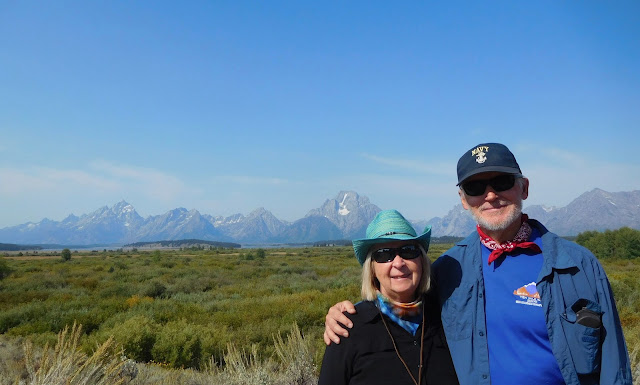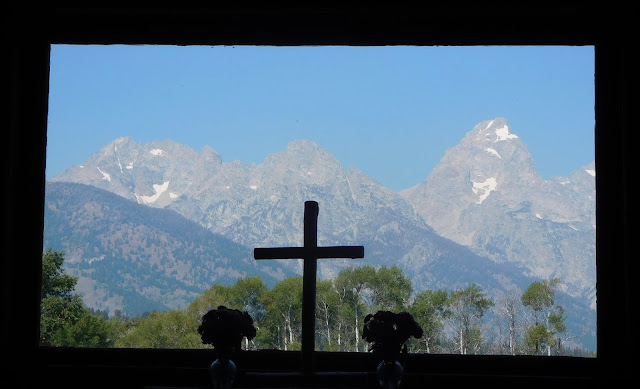Carol writes: The next three weeks of our on-the-road adventure were some of the most anticipated in all of 2017. We planned a week in Grand Teton National Park followed by two weeks in Yellowstone. Together Grand Teton National Park and Yellowstone National Park comprise the so-called Greater Yellowstone Ecosystem (GYE), in the northwest corner of Wyoming. This outstanding gem of the Creator’s artistry has drawn visitors from all over the world, and it wasn’t at all unusual to hear two or three different languages being spoken at once anywhere in the park.
As soon as we had nestled into our cozy little campsite at Coulter Bay, we decided to take our customary “look around” our new temporary home.
As we headed back to camp, we were very surprised to have our first bear sighting! A big black bear was chomping on some tasty bushes and was quite unconcerned with the handful of humans who were quietly enjoying him from a distance. Way at the end of my comfort zone, I freaked for a nanosecond, then soon felt better while talking to an elderly couple who had fled to their car. It was understood that their back seat would be mine if the bear made any moves…
There were dozens of horrendous forest fires raging west of us in Oregon and Montana, and it was only a matter of time before the smoke would drift east… so the next day the first order of business was to immerse ourselves in the beauty and majesty of those lovely Tetons while the skies were blue and visibility was good.
An interesting factoid that usually puts a smile on the faces of visitors is that the Tetons were named by French fur trappers, lonely and no doubt solitary men who called these mountains Les Trois Tetons, meaning the three breasts.
The Teton Mountains form the western border of Jackson Hole, a 40-mile-long valley encircled by mountains, with no foothills to obstruct the view. We packed a picnic lunch for our exploration of Jackson Hole, and when no convenient picnic tables could be found, we improvised for what turned out to be the most perfect lunch spot I could imagine. And we had it all to ourselves…
Some of the most photogenic scenes in Jackson Hole were the places where early settlers made a go at life. And so it was at an early Mormon settlement that still had a handful of buildings that have survived:
a log cabin,
a more unusual stucco house,
and a much photographed barn… all in an unimaginably beautiful setting at the foot of the Tetons.
For the Episcopals, it was the Chapel of the Transfiguration,
with a positively spiritual view through the window over the altar.
None other than Ansel Adams, one of the most famous black and white landscape photographers of the American West, chose the Tetons as subject matter for some of his works.
There was the Ansel Adams version from a viewpoint along the Snake River—
and our much less talented creation of the same view with our camera, showing much taller trees, (with the addition of a “noir” filter available in Mac Photos).
The idea of turning Jackson Hole, with its towering Teton Range to the west, into a national park was not without controversy. Heated debate between local ranchers and wilderness preservationists raged for half a century. In 1923, a meeting at Maude Nobel’s cabin
marked the beginning of a hint of compromise between the two sides, but it wasn’t until 1950 when Grand Teton National Park with its present boundaries was created.
In addition to the majestic views and abundant wildlife, Grant Teton National Park has preserved some of the human stories that are so much a part of the history. One such remarkable couple named Olaus and Mardy Murie lived in a cabin
at the foot of the Tetons.
Olaus and Mardy met and married in Alaska and dedicated much of their life together to protecting the Arctic National Wildlife Refuge, in addition to passionately supporting Teton wilderness issues after moving to Wyoming in 1927. Olaus was nicknamed the “Father of Modern Elk Management;” Mardy was affectionately dubbed the “Grandmother of the Conservation Movement.”
The couple was well known to musician John Denver, who wrote a special song just for them. As part of an hourlong talk on the porch of the Murie cabin, the docent opened up the living room of the simple Murie cabin and played a live recording of the John Denver song dedicated to Olaus and Mardy. Any couple that wished was invited to dance in the main room of the cabin. That was an invitation we couldn’t resist. What a sweet experience waltzing to a John Denver song in the cabin where Olaus and Mardy loved to dance…
The couple was well known to musician John Denver, who wrote a special song just for them. As part of an hourlong talk on the porch of the Murie cabin, the docent opened up the living room of the simple Murie cabin and played a live recording of the John Denver song dedicated to Olaus and Mardy. Any couple that wished was invited to dance in the main room of the cabin. That was an invitation we couldn’t resist. What a sweet experience waltzing to a John Denver song in the cabin where Olaus and Mardy loved to dance…
That sure was a wonderfully uplifting week in Grand Teton National Park. During our visit, more than one ranger was heard boasting that most visitors come to this unique part of Wyoming because of Yellowstone, but it is the Tetons that brings them back. I believe we have succumbed to the magic of the Tetons…
The grand lift of the Tetons is… a primal gesture of the Earth beneath a greater sky.” Ansel Adams



















Great post and commentary as always is almost poetic. The images are wonderful even with your scruffy "mountain man" grinning at us. Note the last picture has a stron indication that a black bear had wandered to close.
ReplyDelete